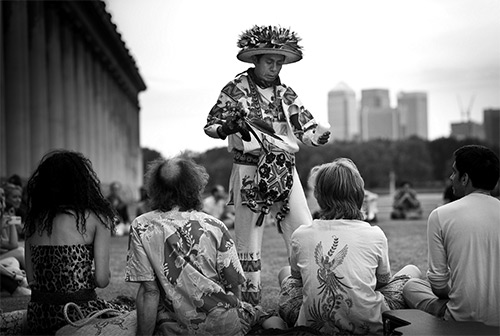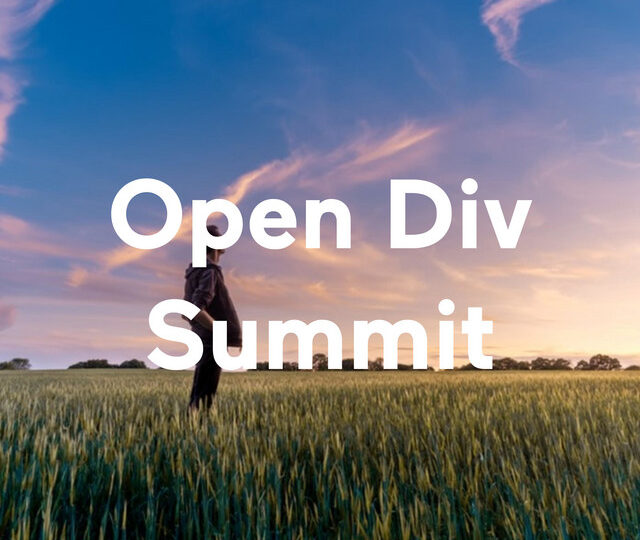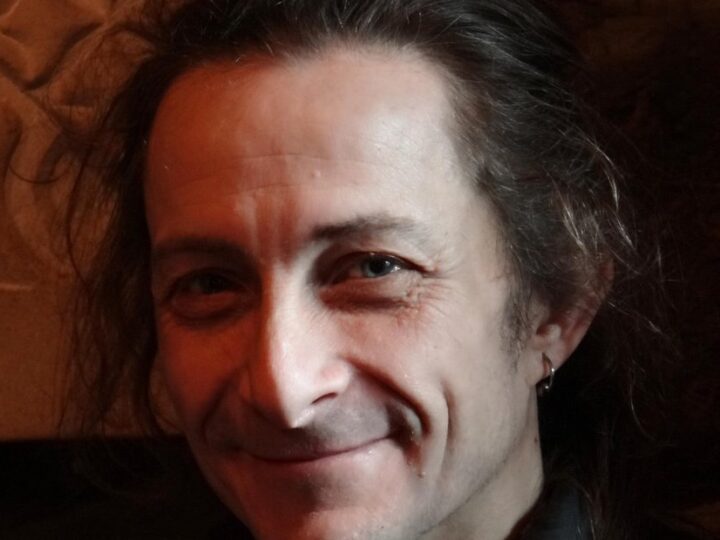
Psychedelic Discourse
I have been writing about psychedelics and psychedelic culture, off and on, for nearly all of my professional life. When starting out as a journalist over two decades ago, I penned articles on Terence McKenna, Burning Man, and the early psy-trance scene; later, I wrote think-pieces about Erowid, research chemicals, and the psychedelic roots of American Buddhism. In 1993, I flew out from New York to Santa Cruz for the Bicycle Day gathering, and began attending and eventually speaking at other conferences centered around what were then more widely known as “entheogens”.
I was fascinated with many of the substances, but what really attracted me to these gatherings was the variegated tapestry of their discourse: the stories, conversations, insights, rants, reports, visions, myths, data, and debates that made up the wild chatter of the scene. I encountered a powerful paradox: though personal encounters with psychedelics are often characterized as ineffable–something that must be known through experience rather than words–these encounters nonetheless seemed to generate an enormous amount of text and talk.
Part of what makes psychedelic discourse so compelling is its kaleidoscopic diversity. A thorough assessment of the topic would ideally engage history, poetry, ethnobotany, religion, law, pharmacology, occultism, neuroscience, anthropology, cultural politics, mythology, literature, psychology, mysticism, and–crucially–first-person testimonies.
Many of the most significant and entertaining psychedelic texts are defined by such diversity–here I am thinking of the encyclopedic poetics of Dale Pendell’s Pharmakopoeia series, or the magisterial scope of Stephan Beyer’s Singing to the Plants, which, despite its scholarly sobriety, looks at ayahuasca through a dizzying array of lenses, including the author’s own experience as an apprentice of mestizo shamans. This sort of multidisciplinarity is evident in the bookshelves of most entheophiles, in online repositories like Erowid, in the seminal texts of Jonathan Ott, and in the fascinating texture of psychedelic conferences, where cross-talk takes place between painters and botany nerds, skeptics and mystics, the underground and the overground.
I had the opportunity to plunge into these swirling waters yet again when I attended Breaking Convention, held in London over a sweltering July weekend this past summer. Billed as a “Multidisciplinary Conference on Psychedelic Consciousness”, the gathering was, refreshingly, actually multidisciplinary. There were presentations by professional scientists, psychedelic musicians, countercultural historians, underground chemists, academically-trained philosophers, mystic healers, paranormal researchers, working shamans, and visionary freaks. Though I was unable to simultaneously attend all three concurrent tracks, and occasionally had to flee the stuffy over-capacity rooms, by the end I felt well glutted on an illuminating and often novel range of insights and points of view. As one of the few Americans at the conference, I absorbed primarily British perspectives, while the many Brazilian researchers who were present–neuroscientists, sociologists, religious historians–offered particularly stimulating angles.
Outside the lecture halls, the usual intense and friendly vibe reigned. Though I wish the bar for “visionary art” had been set a bit higher, the colorful garb, stimulating chatter, and occasional bursts of mystic performance art temporarily transformed the grounds of the University of Greenwich into a liminal zone, what Michel Foucault would call a heterotopia: a social space of otherness, at once physical and interpsychic, that emerges in the midst of the normal run of things.
Psychedelics are “hyper-objects” that demand this multiplicity of perspectives. But their trickster dance is also a concrete result of prohibition, which made psychedelics verboten for all but the most courageous members of the professional class, and thus forced psychedelic discourse into marginalized discursive zones where boundaries were inevitably blurry. This was particularly true in the pre-web 20th century, when there were far fewer psychedelic conferences, and when they were more necessary to stitch the various scenes together. Whether devoted to psilocybin mushroom science or altered states of consciousness, entheogenic gatherings in the 1970s, 80s, and 90s were all in some fundamental sense liminal. They were either underground, self-identified as countercultural, or surfing the edge of institutional respectability.
Some of the more visible colloquia of those years–like “LSD: A Generation Later” (1977), the Psychedelics and Spirituality conference (1983), and Bruce Eisner’s galvanizing Bridge Conference (1991)–took place at academic institutions, generally in California. But even these officially- sanctioned gatherings invariably featured speakers who were working (and speaking) outside of conventional institutional boundaries, whether they were writers, transpersonal therapists, spiritual teachers, or notorious fringe raconteurs like Tim Leary, Terence McKenna, and Robert Anton Wilson.
This countercultural fringe, of course, provides the most colorful vibrations of psychedelia’s discursive rainbow, with its witch’s brew of spirituality, hedonism, science fiction, occult mysticism, and freak philosophy (with or without something resembling “quantum physics”). But the multidisciplinary character of psychedelia also reflects one crucial and under-acknowledged reality: prohibition did not halt serious research.
Indeed, one of the biggest fibs bandied about in discussions of the current research revival is the (often self-serving) claim that psychedelic science ground to a halt in the 1960s and is now “back”. This is true only if you somehow believe that science needs the imprimatur of the state in order to actually be science.
What actually happened was that droves of individuals (with and quite often without academic pedigrees) pursued all manner of hard-nosed research, including ethnobotany, chemical analysis, novel synthesis, extraction methods, and therapeutic protocols. Many DIY researchers were driven to share their results as well, not only through underground publications, mail networks, computer bulletin boards, and friendships, but through formal and semi-formal gatherings devoted to open dialogue. Perhaps the most well known and influential of these smaller gatherings were the annual Entheobotany gatherings produced by the Botanical Preservation Corps. These seminars, held in the 1990s, mostly took place at a legendary hotel in Palenque, Mexico. Though Terence McKenna’s eclectic and incandescent raps were a big draw, the Entheobotany seminars were, like the two recent Psychedelic Science conferences, largely devoted to psychopharmacological research–albeit with a more outlaw relationship to professionalism and a much greater love of plants.
Palenque’s curious mix of plant geeks and mushroom mystics reminds us that however left-brained their content, psychedelic conferences inevitably serve as gatherings of the tribes, where enthusiasts, seekers, manufacturers, artists, and aficionados can meet in contexts more conducive to conversation than Dead shows or raves. Inevitably, this rabble got its mitts on the mic as well. Conferences like Gathering of the Minds (1994) and the Mind States series (beginning in 1997) brought the explicitly underground current of freakdom, metaphysical speculation, and visionary art strongly into the mix, weaving presentations by artists, cultural historians, and far-out psychonauts alongside more established ethnobotanical, legal, and transpersonal presentations.
In the 2000s, the conference format also started making influential in-roads into psychedelic festivals, weaving psychedelic discourse more directly into the underground fabric of substance-fueled celebration and gathering. Stand-out examples here include the “Liminal Village” at the semi-annual BOOM festival, and Lorenzo Hagerty’s Palenque Norte, which pioneered the public (and psychedelic) lecture format at Burning Man. In these contexts, in the lecture hall or the festival tent, psychedelic discourse becomes multidisciplinary less by involving a wide range of authorities than by performing that knowledge within an open, informal context that draws people in with widely varying degrees of formal training, philosophical persuasion, and social authority. It can be goofy, and it can sometimes be wrong, but heterotopia can also be a cognitive blast.
The world of psychedelic discourse is currently experiencing a tectonic shift due to the return to officially sanctioned human-subject research with psychedelics and the corresponding opening of mainstream organs like the New York Times to positive accounts of entheogens as agents of psychological healing. This opening has attracted a wide number of scientific, journalistic, and commercial actors, but much of the mobilization of the emerging discourse can be laid at the feet of the Multidisciplinary Association for Psychedelic Studies (MAPS), either indirectly through the organization’s research efforts, or directly through its various outreach and publicity campaigns. To lift the title from a recent Psychedelic Science talk by Brad Burges (the organization’s director of communications), MAPS is quite consciously “repositioning” psychedelics in the public mind. And one of the best ways to see this repositioning in action is to take a glance at the large, very public, and very successful psychedelic conferences that MAPS has sponsored or co-sponsored in recent years.
On the surface, MAPS’s 25th anniversary gathering and the two Psychedelic Science conferences (co-sponsored with the Beckley Foundation, the Heffter Research Institute, and the Council on Spiritual Practices) seem like good ole kaleidoscopic affairs. Familiar psychedelic elders are part of the program, the vendor space is full of colorful characters, and the attendant EDM-fueled parties and giclée visionary art prints suggest an underground vibe. Although MAPS itself emerged from liminal roots, and still claims multidisciplinarity, the organization now presents a far more homogenous and controlled portrait of psychedelic discourse. Consider the program schedule for Psychedelic Science 2013, which included three tracks: clinical, “interdisciplinary”, and ayahuasca. The clinical track, as you might expect, featured professional PhDs and MDs speaking in dry terms about above-board research; the ayahuasca track, for which MAPS recruited an outside programmer, is another story I will address in a moment. What interests me here is what MAPS means by “interdisciplinary”.
 |
If you consider psychotherapy to be “clinical”, then well over half of the interdisciplinary presentations could have fit into the clinical track; indeed many seemed like spill-overs from the conference’s central hard science focus. Within the remaining presentations we find a smattering of ethnobotanical reports, a few Buddhist and transpersonal perspectives, some old-guard presentations by Ralph Metzner and Ann Shulgin, and one genuinely novel neuro-phenomenological assessment of psychedelic linguistics by Diana Slattery. The underground was largely absent–David Nickels, of the DMT-Nexus, was the only younger speaker whose cheeky photo and personal bio suggested personal links to the freak scene. Even discussions about the underground–such as Erowid’s ever-popular “State of the Stone” talk–were kept to a minimum, despite the extraordinary growth of novel research chemical use in recent years. This discursive marginalization was in turn mirrored in the layout of the conference: the vendor room, where the culture of current entheogenophiles was closest to the surface, was conspicuously tucked away from the main traffic flows.
One might counter that the MAPS conferences are devoted to Psychedelic Science, and that plenty of other gatherings these days keep the freak flag flying. True enough, but only if we define “science” narrowly. MAPS is not trying to keep pure research front and center–if they were, you’d hear a lot more from botanists, ethno- or otherwise, professional or not. Instead, MAPS wants to domesticate psychedelics into regulated psychotherapeutic and clinical medicines–not “plant medicines” (an anthropological category) but pharmaceutical “solutions”.
It’s an expensive, slow, and politically sensitive agenda, one that requires laborious clinical trials, massive fundraising, conservative institutional partners, and the savvy rebranding of compounds still associated by many with pacifier-sucking ravers and crazy hippies. For MAPS’s roughly 30 million dollar project to allow MDMA use in clinical centers to succeed, the edgy discourse of the underground–with its roots in 60s counterculture, ecstatic hedonism, and all manner of intellectual and spiritual heresies–must be scraped away like dross from an opium pipe. But despite recent partnerships with very “square” groups, funding pressures put MAPS in a odd bind: the organization must continue to cultivate psychedelic funders whose core values need to be accommodated while simultaneously being swept under the carpet.
This complicated dance helps explain why MAPS brought in the Brazilian social anthropologist Beatriz Labate to program the ayahuasca track. While Brazil is producing some fantastic psychedelic science, the visionary and exotic charisma of the tea also plays to MAPS’s base. Moreover, in light of the 2006 Supreme Court decision regarding the União do Vegetal, ayahuasca is already being reframed according to another legitimizing discourse: religion. Not spirituality, or visionary mysticism, or tripping balls, but organized religion.
This is an important point: as a recent Erowid Wisdom Cycle survey makes clear, serious long-term aficionados of psychedelics are usually not members of religious institutions; for many, psychedelics offer a “spiritual but not religious” path that precisely avoids formal rituals and top-down belief systems. However, extrapolating from Psychedelic Science, one can glimpse an ironic future where individuals will be able to consume psychedelics without fear of incarceration, but only if they agree to submit to the authority of a licensed medical therapist or a state-sanctioned church.
At the same time, the substance and the popularity of the ayahuasca track also suggests that the move towards Big Science will be ghosted, for the foreseeable future, by a more humanistic and critical array of perspectives. Because of the legal status of ayahuasca in Brazil, and because of the creative pluralism of ayahuasca religions in the country, social scientists there have been studying it intensively. So alongside addiction studies and reports on brain imaging, Labate’s track included scholarly discussions of ritual dynamics, cultural commodification, and the esoteric history and global transformation of ayahuasca sects.
Ayahuasca, it seems, carries its own kaleidoscope with it, an ever-shifting gaze that keeps us, in William Blake’s terms, “from single vision & Newton’s sleep”–in other words, from reductionism. This message was brought home at Breaking Convention with an illuminating talk by Brazilian anthropologist Alberto Groisman. When it comes to understanding the tea, Groisman argued, neuroscience and psychoanalysis miss the boat because they focus too much on the individual, rather than on the wider field of social relationships that compose the context of personal experience. Groisman studies Barquinha (translates as “little boat”), a particularly vivid ayahuasca religion that features incorporation–aka, “possession”–by orixa-like entities during services. In preparation for his talk, Groisman had filmed the ritual invocation of a preta velha (old black woman) named Vó Nadir (Granny Nadir), a spirit who suffered and died as a slave on a sugar plantation and now radiates kindness and compassion. Like a good ethnographer, Groisman sought permission from the human participants in order to show the film at Breaking Convention. They agreed, but Groisman then realized that he needed permission from Vó Nadir as well. Unfortunately for us, the preta velha did not show up in a subsequent service, so we did not see the clip. If Groisman had been a sect member, his request to the spirit would be understandable, and only so interesting. But as an observer and a social scientist, his act of politesse–communicated to us in a liminal conference room–opened up a transdisciplinary space where the spirits and the humans and the molecules weave their multiplex array.
For “multidisciplinary” MAPS, however, social science basically means psychology, and mainstream, individual-centered psychotherapy at that. Leaving aside the marginalization of underground voices, the “science” of psychedelics needs other approaches, including sociology, medical anthropology, comparative religion, history, and especially science studies, which could help track the construction of psychedelics as “scientific” objects.
Recent studies like Nicolas Langlitz’s Neuropsychedelia, which presents an anthropologist’s philosophical analysis of two psychedelic science labs, point in the right direction. However, these analyses are of more than academic interest, because the reconstruction of psychedelics as pharmaceutical medicines is not innocent, but biopolitical. An important term in contemporary social theory, “biopolitics” refers to the various ways–including the discursive authority of science–that institutions, corporations, and governments manage and police the boundaries and processes of life itself.
The biopolitical implications of MAPS’s work are glaringly obvious in one of their most widely trumpeted projects: the treatment of PTSD with MDMA. Successfully treating anyone’s PTSD is a laudable goal. But the sentimentality and heroic triumphalism that MAPS taps in order to publicize this research (funded by 25 years of contributions from psychedelic freaks) glosses over the disturbing possibility that MDMA therapy could one day be used with active-duty soldiers, a deployment that turns the compound into affective grease for the military machine.
I would like to make clear that I am not against MAPS, nor psychedelic science, nor entheogenic therapy for soldiers. What troubles me is the colonizing and non-reflective nature of these increasingly powerful scientific (and “scientific”) voices, which need to shove aside the authority of other discourses in order to accomplish their agenda. But we should never forget a central axiom of “set and setting”: there is no drug by itself. Instead, what we have are endlessly reverberating feedback loops of mind, cultural context, and compound. Even if neuroscience or psychopharmacology gives us something closer to hard facts, the presentation of “hard facts” is still a theatre of expectation and culture crafting (and not necessarily the most inspiring or courageous one, let alone the “truest”).
As Stephan Beyer suggested at the Psychedelic Science conference, taking shamanism seriously–which means engaging with it rigorously–may require us to abandon the model of psychedelic substances as either neuroscientific objects or therapeutic “tools”. And the best way to train ourselves for this expanded cognitive encounter is to continue to refine the multidisciplinary art of the kaleidoscope.




